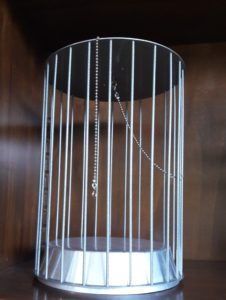
IT – Ideata agli inizi del 1800 dal fisico britannico Michael Faraday, essa è costituita da un conduttore metallico a forma di gabbia, che, una volta caricato, permette di dimostrare che le cariche elettrostatiche si distribuiscono solo sulla superficie esterna del conduttore e non sono presenti all’interno di esso. Per verificare ciò si usano due elettroscopi, uno collegato con la superficie interna della gabbia (che non evidenzia mai carica), l’altro con la superficie esterna della stessa (che evidenzia carica dopo che la gabbia è stata caricata). La gabbia di Faraday è dunque uno schermo elettrostatico, in grado di isolare (da un campo elettromagnetico esterno) qualsiasi oggetto posto al suo interno.
GB – Faraday cage – Designed in the early 1800s by the British physicist Michael Faraday, it consists of a metal conductor in the shape of a cage, which, once charged, allows to demonstrate that electrostatic charges are distributed only on the outer surface of the conductor and are not present at the inside of it. To verify this, two electroscopes are used, one connected with the internal surface of the cage (which never shows charge), the other with the external surface of the same (which highlights charge after the cage has been loaded). The Faraday cage is therefore an electrostatic screen, capable of isolating (from an external electromagnetic field) any object placed inside it.